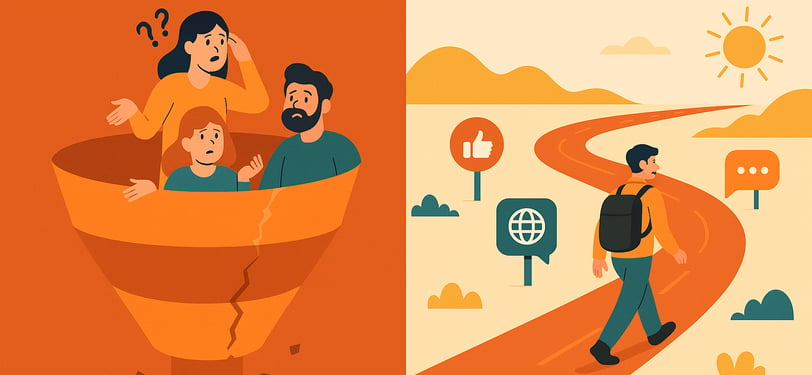From Traditional Marketing Funnel to User Path: Why You’re Not Closing Sales Online
Mateo Velasquez
2 min read


You’ve built a marketing funnel, followed the steps, and launched your campaigns —
Yet the sales just aren’t coming through.
Here’s the truth: it’s not that your funnel is broken — it’s that your funnel is too generic.
To fix that, you need to shift your mindset from the traditional funnel to something more useful: your brand’s actual User Path.
The funnel is not enough
The classic marketing funnel has three standard stages:
Awareness
Consideration
Conversion
While it’s a helpful model, it’s also oversimplified. It doesn’t reflect the real journey your customers take, nor the specific steps they need to go through to trust — and choose — your brand.
What you really need is a custom path designed around your user behavior, not textbook theory.
What’s a User Path?
A User Path is a step-by-step map of how someone actually moves from discovering your brand to becoming a customer.
The key difference?
You build it based on your own business model, channels, audience behavior, and offer.
This makes it actionable, measurable, and aligned with real-world data.
Step 1: Map the actual customer journey
Forget about the generic funnel for a moment.
Start by reconstructing what truly happens between first contact and final purchase.
Ask yourself:
Where do users first hear about me?
What happens next?
Where do most of them drop off?
How many steps are there, really?
What channels are they using?
You can sketch this as a flowchart or user journey diagram — whatever helps you visualize the process clearly.
Step 2: Define trackable indicators for each stage
Once you’ve mapped the journey, assign a measurable indicator for every step in the path.
Example:
First step: user sees your ad → metric = reach
Second step: visits your profile → metric = profile visits
Next step: clicks your link → metric = CTR
Next: views product page → metric = page views
Final: completes purchase → metric = conversions
Now you can pinpoint exactly where you’re losing potential customers — and why.
Step 3: Track, analyze, improve
With your User Path and indicators in place, it’s time to go into monitoring mode.
Track performance at every step
Identify bottlenecks and drop-offs
Launch targeted fixes for specific stages
Are users failing to click through from your ad?
Are they bouncing from your site before exploring offers?
Is your checkout process turning them away?
You can’t improve what you can’t measure — and you can’t measure what you haven’t mapped.
Final Thought: It’s not the funnel — it’s how you approach marketing
You’re not closing online sales because you’re following a one-size-fits-all funnel model.
When you build your own path, with your own data and stages, marketing becomes strategic — and effective.
Stop applying frameworks that don’t fit your business.
Start mapping how your customer really buys.
